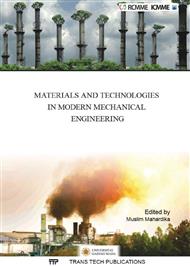p.67
p.74
p.83
p.92
p.99
p.103
p.111
p.115
p.120
The Influence of Quench Tempering and Carburazing Treatment towards Mechanical Properties and Microstructure of Medium Carbon Steel for Automotive Application
Abstract:
Gear is one of the machine components that is widely used in industrial and automotive fields. In machinery process, gear has a very important function to forward speed, power, or torque from one engine component to other components as a mechanical drive. Today a lot of development to obtain a good quality of gear, due to many gears were damage, worn out, and broken because they were not strong enough to resist friction and pressure. In addition, broken gears due to pressure and friction make them did not last long. To increase the hardness value of gear, then it needs though material that can be used when the gear reach optimum rotation. The material that is widely used for gear application is medium carbon steel. The medium carbon steel is a metal material that has carbon composition ranging from 0.30 to 0.59%. This medium carbon steel has hardness value of 174.501 HVN without treatment. The process of quench tempering and carburizing are conducted to increase hardness and toughness value of the material. The hardness value of gear is 140 HVN. The result of the research showed the hardness value at various temperature 780°C, 810°C, and 840°C. The optimum hardness values is 165.355 HVN at the temperature of 840°C. Medium carbon steel is expected to be an alternative to produce steel material with certain mechanical properties. This research also conducted heat treatment in austenite area and then detained with holding time of 20, 40, and 60 minutes. Furthermore, quench tempering was conducted and followed by carburizing to obtain a ferrite phase and coarse pearlite and to increase hardness value after quech tempering. It is expected that after quech tempering and carburizing process, steel with better mechanical properties can be produced. This research obtained the increase of hardness value and the number of pearlite and ferrite.
Info:
Periodical:
Pages:
99-102
Citation:
Online since:
June 2016
Authors:
Keywords:
Price:
Сopyright:
© 2016 Trans Tech Publications Ltd. All Rights Reserved
Share:
Citation:


